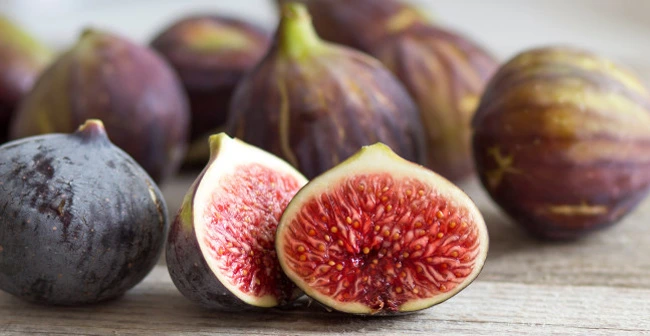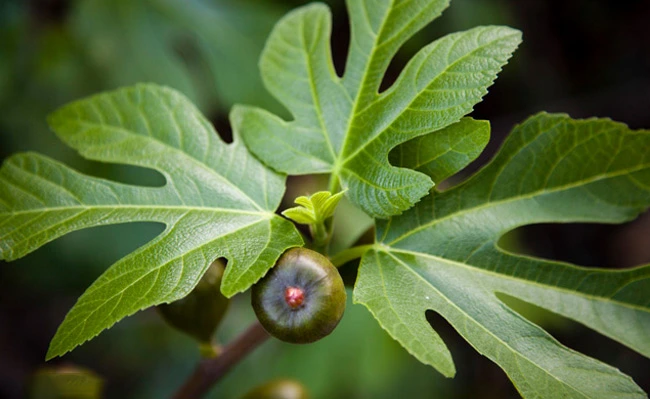You have probably known figs your entire life. You have heard or read about “figs” a thousand times. They have a sweet taste and feature a complex texture that joins the chewiness of their flesh, the sleekness of their skin, and the crunchiness of their seeds.
Figs are perishable fruits, so they are mostly available as dried fruits for healthy snacks. Figs are also a popular ingredient in many famous cookies, such as fig bars and fig cakes, and a culinary delicacy par excellence.
However, there are still many things to learn about figs (or Anjeers), such as their origin, rich history, production, nutrition facts, and benefits and downsides.
In this article, we take a glimpse at this peculiar fruit’s life, as well as its health benefits and uses.
- 1-Unique Properties of Figs
- 2-Figs Taste like Honey
- 3-Rich Culinary and Non-culinary History
- 4-Botany: An Insect Is Involved
- 5-Habitats: A Water Needy Plant
- 6-Cultivation: Variety of Purposes
- 7-Fig Propagation: Vegetative vs. Sexual
- 8-Nutrition Facts: No Fat at All
- 9-Figs Benefits and Side Effects: A Double-Edged Dagger
- 10-Top Fig Producing Countries
1-Unique Properties of Figs
You probably wonder “what is different about figs in relation to other fruits?” Here are some of the unique attributes of figs (tree and fruit):
Fruit Shape and Color
A fig is a soft teardrop-shaped tree fruit with a purple to brown skin (at ripening) with a sweet soft reddish flesh containing numerous crunchy seeds (figure 1). The skin turns white or yellow after drying.
A Syconium Fruit
Each “fig” is a multiple fruit ensembled from many tiny fruits. If you cut open a fig, you will see the inside lined with small seeds, and each is considered a “fruit.” So the fig is a false fruit that bears numerous one-seeded fruits.

Ostiole or eye
Figs are also different from other fruits in having an opening, called the “eye” or “ostiole,” which allows a specialized fig wasp to reach inside for sap, bringing in pollen from a relative fig variety (caprifig) for pollination.
Milky Sap
Another peculiar thing about figs is that the green parts of the fig plants produce a milky sap or syrup when broken. The milky sap of green figs is produced by elongated cells, known as laticifer cells, and is an irritant to human skin.
No External blossoms
Figs never blossom externally like other plants. Instead, blossoms appear inside the fig structure (inflorescence). Blossoms later form small seeds.
Fig Seasons
Another peculiar thing about figs perhaps is their dual season. There are two fig seasons: summer and fall. Some varieties produce only one crop, in summer or fall. Some bear two crops, the first maturing in early summer on wood of the previous growth and the second ripening in late summer or fall in the axils of the leaves of the same season.
The fruits in the early summer harvest are smaller. The late summer and early fall harvest fruits are larger, with thicker skins and more concentrated sweetness.
There are more types of figs varieties than any other plant can have (a discussion we have taken up in a different article).
2-Figs Taste like Honey
Figs are appreciated for their honey-like sweetness with a definite hint of berry and soft, jammy texture studded with noticeable tiny seeds that give it a crunch. A delicate, ripe fig is massive with its syrupy cocktail, which tends to drizzle out of its center if you wait too long to eat it. Dried figs have a concentrated sweetness and a chewy texture.
A mild, untouched fig is an extraordinary food. That is why chefs are hesitant to include them in fig recipes. A recipe indicates cooking or the manipulation of ingredients. Fresh figs need neither manipulation nor fuss.
3-Rich Culinary and Non-culinary History
Being among the earliest fruits used by humans, there is a complex and symbolic story about figs in history. Ficus carica L., generally known as “fig,” originated in Northern Asia and expanded with the Greeks and the Romans throughout the Mediterranean region.
Sumerian stone tablets dating back to 2500 B.C. show culinary use of figs, and remains of fig trees were discovered during exhuming Neolithic sites from 5000 B.C. Some recorders consider it the first of the domesticated crops. Known as the “Forbidden Fruit” and the “Fruit of the God,” fig is the first tree mentioned in the Bible is the story of Adam and Eve. Some biblical scholars believe the fig, and not the apple, was the forbidden fruit picked by Eve in the Garden of Eden. It is said that Adam and Eve used fig leaves to cover their nakedness.
“And the eyes of them both were opened, and they knew that they were naked, and they sewed fig leaves together and made themselves aprons.” (Genesis 3:7).
Figs hold a position of symbolism in many religions, including Islam, Christianity, Hinduism, Buddhism, and Judaism, symbolizing fertility, peace, and victory. The Greeks used these “sweet drops” as signs of victory and for ancient Olympic training. Ancient Olympians received figs for their athletic prowess, and Pliny the Elder admired the fruit’s restorative powers. The Prophet Mohammed reportedly named fig as the fruit he would most wish to see in heaven.
4-Botany: An Insect Is Involved
The Tree
Figs develop on a deciduous small tree or bush (Ficus carica) that grows up to 10-12 meters tall with smooth white bark. The leaves are large and have 3-5 lobes. They fall in the cold seasons.

Organization of the Fruit
The fruit is what we call “syconium,” a fleshy, hollow structure lined internally with numerous unisexual (separate female or male). Tiny asepal flowers inside the fig structure later develop into hard fruits or seeds.
Pollination and Fertilization
Figs never blossom externally like other plants (another peculiar fact about figs). Blossoms appear instead inside the fig structure (inflorescence). Pollination takes place with the help of a specialized fig wasp, which enters the fig structure through the eye or ostiole. The fig wasps carry pollen from the caprifigs (a wild relative of figs) to pollinate the edible and inedible figs.
5-Habitats: A Water Needy Plant
The common fig tree grows wild in dry and sunny or rocky locations at sea levels to 17,000 meters in elevations. It prefers porous and free-draining soil but it can do well in nutritionally poor soil and can tolerate seasonal droughts.
The “rock fig” or “mountain fig” is a wild variety of figs that can grow well in cold, dry climates of Iran’s mountains, e.g., semi-arid montane regions.
Middle Eastern and Mediterranean climates especially suit fig plants, allowing them to grow into considerable size as large, dense, shade trees. The tree has a great need for water, so it frequently grows in locations with standing or running water, such as in valleys of rivers and in ravines that collect water.
6-Cultivation: Variety of Purposes
Ancient Cultivation
The common fig is one of the oldest cultivated tree fruits. According to new archeological findings, fig cultivation is the first known instance of agriculture, preceding wheat, barley, and legume. Early fig growers cultivated female figs and scattered pollen dust on female fig structures to help with fertilization. Figs were cultivated in a large region that spanned West Asia and Europe, from Afghanistan to Portugal.
Figs were cultivated, and the fruit was commonly used as a food source for Roman soldiers. The fig fruits were also used to fatten goose, which was used as a precursor of foie gras, a food product made of goose or duck liver.
Modern Cultivation
Modern fig growers cultivate it for various purposes: for edible fruits, as an ornamental tree, or for its unusual foliage (such as in the case of ‘Brown Turkey’ and ‘Ice Crystal’ varieties that have gained royal recognition).
7-Fig Propagation: Vegetative vs. Sexual
Sexual Propagation
You can reproduce figs via seeds. Figs seed propagation is an uncertain but easy way to multiply a fig tree. It will often result in a new cultivar, and you do not know beforehand if you are growing a female or male plant.
Vegetative Propagation
Figs propagation is mainly vegetative. Although common figs are capable of producing fertile seeds if pollinated properly, propagation takes place by taking cuttings of dormant woods and plating them in nursery rows in February in the northern hemisphere. By the end of the growing season, the cuttings have grown to 1 meter tall and are ready for transplanting. Figs are planted in the field and receive water only from the natural rainfall. However, the pot culture of figs in greenhouses has been a long practice in some regions such as England (figure 2).
8-Nutrition Facts: No Fat at All
What is interesting about fig fruit is that it contains no fat and no proteins. Figs are a powerhouse of other nutrients such as potassium, calcium, magnesium, copper, antioxidants like vitamin A and Vitamin L, sugar, and soluble fiber, contributing to overall health and wellness. (Table 1).
Another interesting fact about fig fruit is its low-calorie content; 40 grams of fresh figs contain only 30 calories, and provide 2 to 3 % of the daily value (DV) or references daily intake (RDI) of essential nutrients. Dried figs, on the other hand, are high in sugar and rich in calories because the sugar becomes concentrated after drying
🔰 Figs both fresh and dry are an excellent source of iron, the one mineral that is important for the normal growth of all of us, especially young women.
| Calories | 30 |
| Protein | 0 grams |
| Fat | 0 grams |
| Carbs | 8 grams |
| Fiber | 1 grams |
| Copper | 3% of RDI (referenced daily intake) |
| Magnesium | 2% of RDI |
| Iron | 6% of RDI |
| Potassium | 2% of RDI |
| Riboflavin | 2% of RDI |
| Thiamine | 2% RDI |
| Vitamin B6 | 3% of RDI |
| Vitamin K | 2% of RDI |
Using Figs in Dietary
You can include figs in your diet in four different ways:
Fresh figs:
Fresh figs make a great healthy snack. They can also be used in salads and desserts. You can also make jams and preserves using fresh figs.
Dried figs:
Dried figs are produced either by exposing the fresh figs to sunlight or dehydrating them in a dryer. They provide sweet and nutritious dried fruits with miraculous health benefits. The dried fig is also known as Anjeer.
Dried figs are a known home remedy for constipation. Eating them is also linked with a reduced risk of obesity. However, they have more calories and sugar than fresh figs, so they should be eaten in moderation.
Fig Leaves:
Fig leaves can be used the same way we use grape leaves, for example for wrapping rice, meat, and other fillings
Fig Leaf Tea:
You can make your own fig leaf tea by drying and chopping fig leaves or buy it from a specialty store.
9-Figs Benefits and Side Effects: A Double-Edged Dagger
The nutrient composition and texture of figs give rise to many health benefits, such as the following:
🟢 Figs help promote digestive health: Figs have been historically known as a home remedy to alleviate digestive problems such as constipation by softening and adding bulk to stool. Figs also provide a healthy food source for gut bacteria (figs probiotic effects). It has been experimentally shown that people who consume 4 dried figs (about 45 grams) twice a day would experience significantly fewer digestive issues, including pain, bloating, and constipation.
🟢 Figs can improve skin health: Figs can have beneficial effects on skin problems such as allergic dermatitis, a disorder that causes the skin to become dry or itchy. Research has shown that applying dried fig extract or cream on the skin twice a week can help cure dermatitis more efficiently than standard treatments such as hydrocortisone cream.
Other potential health benefits that are NOT scientifically approved include fig anticancer properties, blood sugar regulation, and vascular heart health.
For side effects,
⭕ Diarrhea, and digestion problems: It is possible to have diarrhea after figs consumption. Figs are commonly used as a home remedy for constipation but they may cause diarrhea as well.
⭕ Interfering with blood thinning medications: Rich vitamin K in figs may interfere with blood thinning medications and make them ineffective.
⭕ Allergic reaction to Figs: Some people may have an allergic reaction to fig fruits or to fig milky sap.
10-Top Fig Producing Countries
The total production of dried figs in the world in 2021 was estimated at 148,400 metric tons. Turkey is the world’s leading dried fig producer, accounting for 58% of the total, followed by Iran (17%). Spain, the United States, Greece, Afghanistan, and Italy collectively shared the following 21% of global production, with shares ranging from 7% to 1% (fig 3).

FAQ
Conclusion
To sum up, figs are peculiar fruits compared to others. They have many nutritional and health benefits. However, figs also have downsides. We recommend keeping track of how much you eat figs to avoid side effects. We excluded the discussion about fig varieties from this article, saving it for another article titled “different types of figs,” which we hope you will find enjoyable. Please leave your comment in the comment section and share this article with your friends and colleagues.


this article has given me a new appreciation for these delicious fruits, and I look forward to incorporating them into my diet even more. Thanks for sharing!
Very informative. To the point and well prganized
I like these topics very much. I would like to see such topics daily, this post is very good indeed. There are people like you in the world who put forth their views. Thank you so much for posting such a great post.